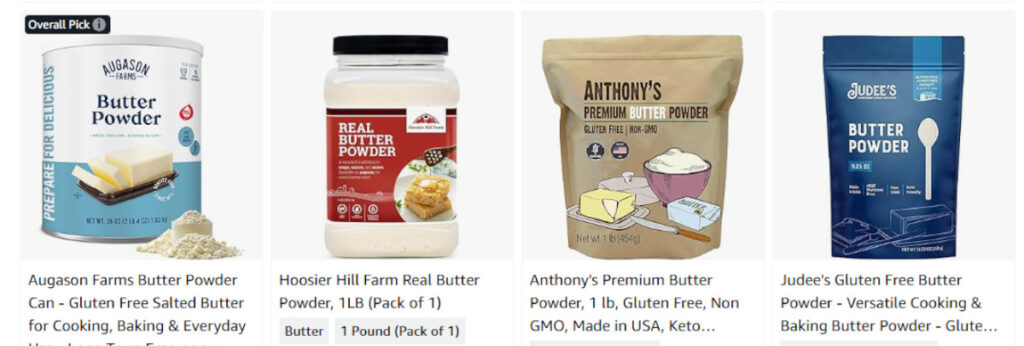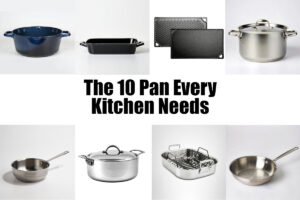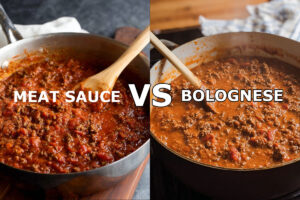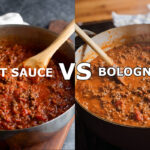Everything you need to know about powdered butter – from basic uses to gourmet recipes that’ll change how you cook
Hey there, fellow food adventurers! If you’ve been curious about powdered butter but weren’t sure where to start, you’ve landed in exactly the right place. Whether you’re a camping enthusiast, emergency prepper, or just someone who loves convenient cooking hacks, this guide covers everything you need to know about this game-changing ingredient.
Powdered butter isn’t just some weird food science experiment – it’s actually a brilliant solution for adding rich, buttery flavor without the hassle of refrigeration. I’ve been experimenting with it for years, and trust me, once you understand how versatile this stuff is, you’ll want to keep it stocked in your pantry at all times.
What Is Powdered Butter?
Powdered butter (also called butter powder) is real butter that’s been dehydrated and turned into a shelf-stable powder. It’s made by spray-drying butter with milk solids or maltodextrin, which removes the moisture while preserving that creamy, rich butter flavor we all love.
Think of it as butter’s convenient cousin – all the taste, none of the refrigeration headaches.
How Powdered Butter Is Made
The process is pretty straightforward:
- Real butter is heated until it becomes liquid
- Milk solids are added to help with the drying process
- Spray-drying technology removes all the moisture
- The result? A fine, creamy powder that reconstitutes beautifully
Most quality brands use real butter as the primary ingredient, so you’re getting authentic butter flavor in a more convenient form.
Powdered Butter vs Regular Butter: The Real Comparison
Let’s be completely honest here – if you’re doing a side-by-side taste test of fresh butter versus reconstituted powdered butter, fresh butter is going to win every single time. There’s just no getting around the fact that dehydrating and processing changes the flavor profile somewhat. But here’s the thing: that’s not really a fair comparison, because these two products solve different problems in the kitchen.
Fresh butter is absolutely unbeatable when you’re spreading it on warm toast, making a pan sauce, or doing any kind of high-heat cooking where you need butter’s unique properties. The flavor is pure and intense, the texture is perfect for certain applications, and nothing quite replicates that experience.
But powdered butter shines in completely different situations. When you’re camping and can’t keep anything refrigerated, powdered butter gives you that buttery richness in your campfire cooking that you’d otherwise have to do without. When you’re building an emergency food supply, powdered butter provides essential fats and calories that will stay good for decades without any special storage requirements.
The convenience factor is huge, too. Ever tried to measure out butter for a recipe when it’s rock-hard from the fridge? With powdered butter, you just scoop and measure – no waiting for it to soften, no microwaving and accidentally melting it. For baking especially, powdered butter mixes into dry ingredients beautifully and gives you much better control over texture.
Where powdered butter really excels: It’s lightweight for backpacking, doesn’t require refrigeration for RV travel, stores practically forever for emergency preparedness, and gives you precise portion control that’s hard to achieve with regular butter. Plus, because it’s shelf-stable, you can always have “butter” available even when you’ve run out of the fresh stuff.
The shelf life difference is remarkable. Regular butter might last 1-2 months in your fridge before it starts developing off-flavors. Unopened powdered butter can sit in your pantry for 10-15 years without any degradation in quality. That’s not just convenient – it’s revolutionary if you’re thinking about long-term food storage.
For everyday cooking, think of powdered butter as a specialized tool rather than a replacement. It’s perfect for camping meals, emergency prep, lightweight travel, and situations where you want to add buttery flavor to dry mixes or seasonings. It’s not meant to replace the stick of butter in your fridge, but to expand your cooking options in situations where fresh butter just isn’t practical.
Powdered Butter Complete Storage Guide
Here’s something that always amazes people about powdered butter: when properly stored in its original, commercially sealed container, this stuff will outlast most of us. We’re talking about an effective shelf life that approaches forever – seriously. I’ve seen properly stored powdered butter that’s been sitting in pantries for 15-20 years and still tastes great when reconstituted.
The magic happens during the commercial packaging process. Manufacturers use nitrogen flushing and moisture-barrier packaging that creates an almost perfect environment for long-term storage. As long as that seal remains intact and you store the container in a cool, dry place away from temperature fluctuations, you’re basically set for decades.
But here’s where things get tricky: once you break that seal, powdered butter becomes vulnerable to its three biggest enemies.
The enemy trio that ruins powdered butter: moisture, oxygen, and light. Moisture causes clumping and eventually spoilage. Oxygen leads to rancidity over time. And UV light breaks down the fats, creating off-flavors that’ll make your recipes taste weird.
The smart approach is to treat your opened powdered butter like a precious resource that needs protection. Instead of leaving it in the original container where you’re exposing the entire supply to air every time you use it, portion it out into smaller, protective storage.
My favorite method: Transfer your powdered butter into clean glass canning jars in portion sizes that make sense for your cooking habits. I like quart size mason jars, but adjust the size for how much you are using at a time. Add an oxygen absorber packet to each jar (you can buy these online for cheap), then vacuum seal the jars using either a FoodSaver jar attachment, a manual vacuum pump, or one of those handheld vacuum sealers.
This approach gives you the best of both worlds. You’ve got one “working jar” that you use for daily cooking, while the rest of your supply stays protected in vacuum-sealed storage. The working jar should be kept in a cool, dark place and will stay fresh for 6-12 months. The vacuum-sealed portions? Those will maintain quality for years.
Temperature matters more than you think. Keep your storage area below 70°F if possible. Heat accelerates the breakdown of fats, and nobody wants rancid butter powder. A pantry or basement storage area usually works perfectly.
Signs your powdered butter has gone bad: You’ll smell it before you taste it – rancid powdered butter has a distinct off-odor that’s unmistakable. Visually, it might look darker or more yellow than when fresh, and it may clump together in ways that don’t break up easily. If you reconstitute it and the flavor tastes sharp, bitter, or just “off,” trust your palate and toss it.
Quick tip for occasional users: If you only use powdered butter occasionally, buy smaller containers rather than bulk sizes. Fresh powder always performs better in recipes, and there’s no point in having pounds of the stuff if you’ll only use a few tablespoons per year.
Nutrition Information
Here’s what you’re getting in a typical 1-tablespoon (8g) serving of powdered butter:
- Calories: 35-40
- Fat: 2-3g
- Saturated Fat: 1-2g
- Cholesterol: 5-8mg
- Sodium: 40-60mg
- Carbohydrates: 4-5g
- Protein: 1g
Compared to Regular Butter:
Powdered butter typically has:
- Fewer calories (about half)
- Less fat due to added milk solids
- Slightly more carbs from the drying agents
- Similar vitamin content when reconstituted
Health note: It’s still butter, so enjoy it as part of a balanced diet. The convenience factor often leads to more mindful portion control, which is a nice bonus.
Where to Buy Powdered Butter
Unless you happen to live near a serious prepper supply store or outdoor outfitter, you’re probably going to have better luck shopping online for powdered butter. Most regular grocery stores simply don’t carry it, and when they do, the selection is usually pretty limited and overpriced.

Amazon is honestly your best bet for most situations. They’ve got the widest selection, competitive pricing, and if you’re a Prime member, you can have powdered butter delivered to your door in a couple of days. Plus, you can read real customer reviews to get a sense of which brands actually taste good versus which ones are just cheap fillers with butter flavoring.
When shopping on Amazon, look for brands like Hoosier Hill Farm, Augason Farms, and Anthony’s Goods. These consistently get good reviews for taste and quality. Avoid anything where “butter flavor” appears before actual butter in the ingredients list – you want the real deal, not artificial flavoring.
Thrive Market is another solid online option, especially if you’re interested in organic or non-GMO varieties. Their prices are usually competitive with Amazon, and they focus on higher-quality brands. The downside is that you need a membership, but if you’re already buying other health-focused foods online, it might be worth it.
For serious bulk purchases, check out emergency food supply websites like Emergency Essentials or Mountain House. These companies understand long-term food storage and usually carry high-quality powdered butter in larger containers. The per-pound price is often better when buying in bulk, but only go this route if you’re confident you’ll actually use it.
Specialty outdoor stores like REI or Cabela’s carry powdered butter, but it’s usually the smaller, more expensive packaging aimed at backpackers. Great if you want to try a small amount first, but not cost-effective for regular use.
The bottom line on pricing: Expect to pay somewhere between $8-15 per pound for quality powdered butter, with organic options running a bit higher. Bulk sizes bring the per-pound cost down, but don’t get too caught up in “deals” if it means buying more than you’ll realistically use in a few years.
What to look for when shopping: Real butter should be the first ingredient, not butter flavoring or “natural butter flavor.” Check the ingredient list for minimal additives – the best brands keep it simple with just butter, milk solids, and maybe a small amount of maltodextrin for texture. Read the reviews carefully, especially the ones that mention taste and how well it reconstitutes.
A note about local stores: You might occasionally find powdered butter in the baking aisle at Walmart or Target, but the selection is usually limited to one or two brands, and they’re often more expensive than online options. If you’re in a hurry or want to try before committing to a larger online order, it’s worth checking, but don’t expect to find the best deals or selection in physical stores.
How to Rehydrate and Use Powdered Butter
Basic Reconstitution
The standard ratio is 1:1 powder to water, but you can adjust for your preferred consistency:
- Soft butter consistency: 1 part powder + 1 part warm water
- Firmer spread: 1 part powder + ¾ part water
- Liquid butter: 1 part powder + 1¼ parts water
Method:
- Add warm (not hot) water gradually
- Whisk until smooth
- Let sit for 2-3 minutes to fully hydrate
- Adjust consistency as needed
Direct Usage (No Reconstitution)
For many recipes, you can add the powder directly:
- Baking: Mix into dry ingredients
- Seasonings: Blend with herbs and spices
- Sauces: Whisk into warm liquids
- Coatings: Dust on popcorn or vegetables
25+ Ways to Use Powdered Butter
The versatility of powdered butter really starts to shine once you understand that you don’t always need to reconstitute it with water. Sometimes the best applications involve using it directly as a powder, mixing it into other dry ingredients, or whisking it into warm liquids. Here are 27 specific ways I’ve successfully used powdered butter in my own cooking:
Everyday Cooking & Baking:
- Mix directly into biscuit dough for ultra-rich, flaky biscuits without cutting in cold butter
- Add to cookie batters for deeper butter flavor that stays consistent through baking
- Create just-add-water pancake mix by combining with flour, milk powder, and baking powder
- Whisk into pasta water to create an instant creamy sauce base for any noodle dish
- Blend into mashed potato flakes for creamy, buttery potatoes without dairy spoilage concerns
- Stir into rice while cooking to add richness to plain grains and side dishes
Snacks & Seasonings:
7. Dust fresh popcorn with powdered butter and salt for movie theater flavor at home
8. Sprinkle on vegetables before roasting to create a golden, savory coating
9. Mix with garlic powder and herbs to make custom bread topping that stores long-term
10. Season homemade potato chips by dusting with the powder while they’re still warm
11. Coat nuts and seeds before toasting to create gourmet trail mix ingredients
12. Blend into spice rubs for meat to add richness and help other seasonings stick
Beverages:
13. Add to morning coffee for keto-friendly creaminess and sustained energy
14. Stir into hot chocolate for extra richness without making it too heavy
15. Blend into protein smoothies for additional calories and better mouthfeel
Camping & Outdoor Adventures:
16. Pack for lightweight backpacking meals where every ounce matters
17. Use in campfire cooking when refrigeration isn’t available
18. Create trail meal bases that just need hot water to become complete dishes
19. Stock RV kitchens for space-saving convenience without refrigeration needs
Emergency Preparedness:
20. Store for long-term food security as a shelf-stable fat and protein source
21. Use during power outages when your refrigerator isn’t working
22. Include in disaster preparedness kits for reliable nutrition that won’t spoil
Specialty Applications:
23. Make flavored compound spreads by mixing with honey, garlic, or herbs before reconstituting
24. Enhance pie crust flavor by adding to flour mixture for richer pastry
25. Create shelf-stable frosting base that doesn’t require refrigerated ingredients
26. Thicken soups and stews by whisking powder directly into hot liquid
27. Use in marinades where it helps tenderize meat while adding butter flavor
Each of these applications takes advantage of powdered butter’s unique properties – whether that’s the convenience of not needing refrigeration, the ability to mix into dry ingredients, or the long shelf life that makes it perfect for storage situations. The key is understanding when you want butter flavor versus when you need the specific properties of fresh butter.
Recipe Categories & Links
Breakfast Recipes
- Ultimate Powdered Butter Biscuits
- Emergency Prep Pancakes (coming soon)
- Keto Powdered Butter Coffee (coming soon)
- Campfire Grits (coming soon)
Snacks & Sides
- Movie Night Powdered Butter Popcorn (coming soon)
- 5-Minute Powdered Garlic Butter Spread (coming soon)
Main Dishes
- Backpacker’s Mac and Cheese (coming soon)
- No-Refrigeration Pasta Sauce (coming soon)
Desserts & Baking
- Perfect Powdered Butter Cookies (coming soon)
- Trail Mix Buttercream Frosting (coming soon)
Emergency & Camping Meals
- Powdered Butter Breakfast Burrito Mix (coming soon)
- Emergency Chocolate Cake (coming soon)
Frequently Asked Questions
Does powdered butter taste like real butter?
It’s close, but not identical. Think of it as 80-85% of fresh butter’s flavor intensity. The taste is definitely recognizable as butter, and in many recipes, you won’t notice much difference.
Can I substitute powdered butter for regular butter in any recipe?
Not always. It works great in baked goods, sauces, and mixed dishes. For things like sautéing or spreading on toast, fresh butter is usually better. When substituting, use about 1 tablespoon powder + 1 tablespoon water for every tablespoon of regular butter.
Is powdered butter healthy?
It’s essentially dehydrated butter with some added milk solids, so it has similar nutritional value to regular butter but typically with fewer calories per serving. Like all butter, enjoy it in moderation as part of a balanced diet.
How long does reconstituted powdered butter last?
Once you’ve mixed it with water, treat it like regular butter. Use within a day or two at room temperature, or store in the fridge for up to a week.
Why does my powdered butter taste weird?
This could be due to rancid powder (check expiration dates), too much water making it bland, or poor-quality brands with lots of fillers. Try a different brand or adjust your water ratio.
Can I make my own powdered butter?
It’s technically possible with a food dehydrator and some additives, but commercially made versions are much more convenient and usually better quality. The spray-drying process is hard to replicate at home.
What’s the difference between butter powder and butter flavoring?
Real butter powder contains actual dehydrated butter. Butter flavoring is typically artificial and doesn’t provide the same richness or nutritional value. Always check the ingredient list.
Does powdered butter work for baking?
Absolutely! It’s actually excellent for baking because it distributes evenly through batters and doughs. Many professional bakers use it for certain applications.
Can I use powdered butter for ketogenic diets?
Yes, but check the carb content since some brands add more maltodextrin than others. Pure butter powder brands are better for keto dieters.
What brands do you recommend?
Some popular quality brands include Hoosier Hill Farm, Augason Farms, and Anthony’s Goods. Look for products where butter is the first ingredient and avoid those with too many additives.
Advanced Tips & Tricks
Flavor Enhancement
- Add a pinch of salt when reconstituting to enhance the butter flavor
- Mix with cream cheese powder for an even richer taste
- Blend with garlic powder for instant garlic butter
Cooking Techniques
- Brown the powder in a dry pan before adding water for a nuttier flavor
- Use in bread machines as part of your dry ingredients
- Create compound butters by mixing with herbs before reconstituting
Storage Hacks
- Portion into small containers so you don’t have to open the main container frequently
- Add bay leaves to storage containers to deter insects
- Label with purchase dates to track freshness
The Bottom Line
Powdered butter isn’t going to replace fresh butter in your fridge, but it absolutely deserves a permanent spot in your pantry. Whether you’re planning your next camping trip, building an emergency food stash, or just want a convenient way to add buttery goodness to your cooking, this stuff is incredibly versatile.
The key is understanding what it does well – and what it doesn’t. Use it for baking, seasoning, camping meals, and convenience cooking. Keep fresh butter around for spreading, sautéing, and when you want that pure butter experience.
Start with a small container from a reputable brand, try it in a few recipes, and see how it fits into your cooking style. I’m betting you’ll find at least half a dozen ways to use it regularly.
Ready to start cooking with powdered butter? Check out our Ultimate Powdered Butter Biscuits Recipe – it’s the perfect introduction to cooking with this versatile ingredient!
Have questions about powdered butter that I didn’t cover? Drop a comment below, and I’ll add the answers to this guide. Happy cooking!








